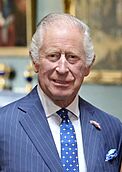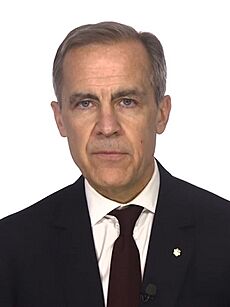Government of Canada facts for kids
Quick facts for kids Government of Canada |
|
|---|---|
| French: Gouvernement du Canada | |
Official wordmark
|
|
| Overview | |
| Leader | Prime Minister (Mark Carney) |
| Appointed by | Governor General (Mary Simon), based on party standings in the House of Commons |
| Main organ | Privy Council (de jure) Cabinet (de facto) |
| Responsible to | House of Commons |
| Headquarters | Ottawa, Ontario |
The Government of Canada (French: Gouvernement du Canada) is the group that manages the country's federal affairs. It's also known as His Majesty's Government. This term mainly refers to the executive branch. This includes the ministers who form the Cabinet, and the many people who work in the federal public service.
The government's structure was set up when Canada became a country in 1867. This happened through a special law called the Constitution Act, 1867. The Canadian Crown (the King or Queen) is at the very heart of Canada's parliamentary democracy.
The King, King Charles III, is Canada's head of state. He is represented in Canada by the Governor General (currently Mary Simon). The Prime Minister (currently Mark Carney) is the head of government. The Prime Minister is chosen by the Crown. This happens after a federal election, when a political party wins enough seats to have the support of the House of Commons. Other important rules for how Canada is governed are found in the Canadian Constitution. This includes written laws, court decisions, and long-standing traditions.
The King's Privy Council for Canada is the group that officially advises the King or his representative on how to use executive power. In practice, the Cabinet does almost all of this work. The Cabinet is like the main committee of the Privy Council. It decides the government's plans and goals for the country. The Prime Minister leads the Cabinet. The King appoints Cabinet members based on the Prime Minister's advice. These members are usually chosen from the House of Commons, but some can be from the Senate.
The government must keep the support of the House of Commons. Important votes, like those on money bills, are considered "confidence votes." Laws are created when bills are passed by both the House of Commons and the Senate. After both houses approve a bill, the King's representative must give it royal assent to make it a law. The government is then responsible for making sure these laws are followed.
Contents
What "Government" Means in Canada
In Canada's parliamentary democracy, the word "government" usually means the Prime Minister, the Cabinet, and other members of the ruling party in the House of Commons. It also includes the many people who work for the federal public service and various government departments.
Sometimes, in news releases, the government is called by the Prime Minister's name, like the "Trudeau Government." This is a common way the media talks about the government.
The Role of the King
Canada is a constitutional monarchy. This means the King or Queen has an important role, but it's not a political one. The monarch holds all the country's power. This power is then shared among different government groups that act under the King's authority. This is why the executive branch is formally called the "King-in-Council."
The King appoints a Governor General (currently Mary Simon) to represent him in Canada. The Governor General can use almost all of the King's special powers. However, some duties must be done by the King himself. If the Governor General is away or unable to act, another person called the administrator of Canada takes over their basic duties.
The King's special powers include giving authority to official documents. Most of these powers are used "in-council." This means they are used based on the advice of the King's Privy Council for Canada (which is usually the Cabinet). In a constitutional monarchy, the King usually follows this advice and doesn't get directly involved in governing.
The Prime Minister and Cabinet
The term "Government of Canada" refers to the actions of the "King-in-Council." The daily work of the Government of Canada is done by its many federal departments and agencies. These are staffed by the Public Service of Canada and the Canadian Armed Forces.
The Prime Minister's Job
One of the King's main duties is to make sure Canada always has a democratic government. This includes appointing a Prime Minister. The Prime Minister leads the Cabinet and guides the government's work. This role isn't written in any specific law. Instead, it's based on a long-standing tradition. This tradition says the King must choose the person most likely to have the support of the elected House of Commons.
In practice, this is usually the leader of the political party that wins the most seats in an election. Currently, this is the Liberal Party, led by Mark Carney. If no single party wins a clear majority of seats, the Governor General will ask a party leader to form a minority government. Once sworn in, the Prime Minister stays in office until they resign or are removed by the Governor General. This can happen if they lose a "motion of no confidence" or are defeated in a general election.
The Privy Council and Cabinet
The Constitution Act, 1867 says that the executive power belongs to the King acting on the advice of the King's Privy Council for Canada. This is called the "King-in-Council." However, the full Privy Council, which includes many former ministers and judges, rarely meets.
In Canada's system, the King usually follows the advice given by the Cabinet. This means the King "reigns" (is the head of state) but does not "rule" (make daily decisions). The Cabinet rules "in trust" for the King. However, the King's special powers belong to the Crown, not to the ministers. In very rare cases, the King might act alone to prevent something clearly against the Constitution.
The Cabinet's Role
Canada's system of responsible government means that those who advise the King must be accountable to the elected House of Commons. So, the daily work of government is guided by a smaller group from the Privy Council called the Cabinet. These individuals must hold seats in Parliament.
The King and Governor General usually follow the advice of their ministers. But the King's special powers belong to the Crown. Ministers only rule "in trust" for the King. If the government loses the support of the House of Commons, the ministers must give the King's power back to the Crown. Then, the Governor General will appoint a new government that can gain the House of Commons' support. The King or Governor General can use these powers alone in very unusual situations, like a constitutional crisis. This helps make sure the government follows the Constitution.
See also
- Structure of the Canadian federal government
- His Majesty's Government (term)
- Canadian order of precedence
- Office-holders of Canada
- Public Service of Canada
- .gc.ca
- Politics of Canada
- Parliament of Canada
- Court system of Canada





